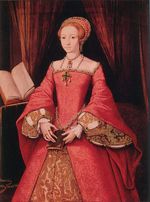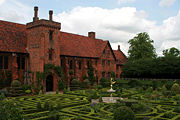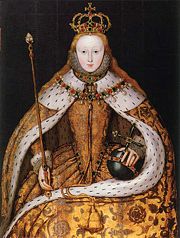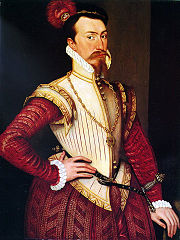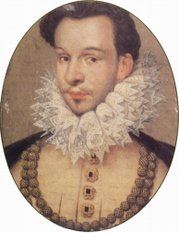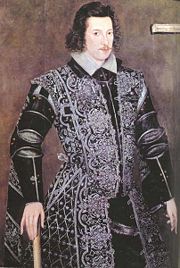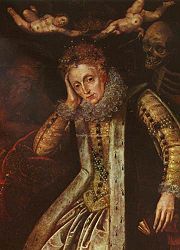Elizabeth I of England
2008/9 Schools Wikipedia Selection. Related subjects: Monarchs of Great Britain
| Elizabeth I | |
|---|---|
| Queen of England and Ireland (more...) | |
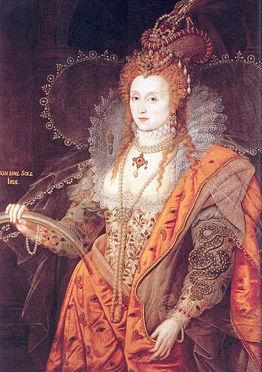 |
|
| The Rainbow Portrait by an unknown artist but attributed to Federico Zuccari, 1600 | |
| Reign | 17 November 1558 – 24 March 1603 |
| Coronation | 15 January 1559 |
| Predecessor | Mary I |
| Successor | James I |
|
Detail Titles and styles |
|
| HM The Queen Lady Elizabeth Tudor Princess Elizabeth |
|
| Royal house | House of Tudor |
| Father | Henry VIII |
| Mother | Anne Boleyn |
| Born | 7 September 1533 Greenwich, England |
| Died | 24 March 1603 (aged 69) Richmond, England |
| Burial | Westminster Abbey |
Elizabeth I ( 7 September 1533 – 24 March 1603) was Queen of England and Queen of Ireland from 17 November 1558 until her death. Sometimes called The Virgin Queen, Gloriana or Good Queen Bess, Elizabeth was the sixth and last monarch of the Tudor dynasty. The daughter of Henry VIII, she was born a princess, but her mother, Anne Boleyn, was executed three years after her birth, and Elizabeth was declared illegitimate. Perhaps for that reason, her brother, Edward VI, cut her out of the succession. His will, however, was set aside, as it contravened the Third Succession Act of 1543, in which Elizabeth was named as successor provided that Mary I of England, Elizabeth's half-sister, should die without issue. In 1558, Elizabeth succeeded Mary, during whose reign she had been imprisoned for nearly a year on suspicion of supporting Protestant rebels.
Elizabeth set out to rule by good counsel, and she depended heavily on a group of trusted advisers led by William Cecil, Baron Burghley. One of her first moves as queen was to support the establishment of an English Protestant church, of which she became the Supreme Governor. This Elizabethan Religious Settlement held firm throughout her reign and later evolved into today's Church of England. It was expected that Elizabeth would marry, but despite several petitions from parliament, she never did. The reasons for this choice are unknown, and they have been much debated. As she grew older, Elizabeth became famous for her virginity, and a cult grew up around her which was celebrated in the portraits, pageants and literature of the day.
In government, Elizabeth was more conservative than her father and siblings. One of her mottos was video et taceo: "I see, and say nothing". This strategy, viewed with impatience by her counsellors, often saved her from political and martial misalliances. Though Elizabeth was cautious in foreign affairs and only half-heartedly supported a number of ineffective, poorly resourced military campaigns in the Netherlands, France and Ireland, the defeat of the Spanish armada in 1588 associated her name forever with what is popularly viewed as one of the greatest victories in British history. Within twenty years of her death, she was being celebrated as the ruler of a golden age, an image that retains its hold on the English people. Elizabeth's reign is known as the Elizabethan era, famous above all for the flourishing of English drama, led by playwrights such as William Shakespeare and Christopher Marlowe, and for the seafaring prowess of English adventurers such as Francis Drake and slave-trader John Hawkins.
Historians, however, tend to be more cautious in their assessment. They often depict Elizabeth as a short-tempered, sometimes indecisive ruler, who enjoyed more than her share of luck. Towards the end of her reign, a series of economic and military problems weakened her popularity to the point where many of her subjects were relieved at her death. Elizabeth is however acknowledged by historians as a charismatic performer and a dogged survivor, in an age when government was ramshackle and limited and when monarchs in neighbouring countries faced internal problems that jeopardised their thrones. Such was the case with Elizabeth's rival, Mary, Queen of Scots, whom she imprisoned in 1568 and eventually had executed in 1587. After the short reigns of Elizabeth's brother and sister, her forty-five years on the throne provided stability for the kingdom and helped forge a sense of national identity.
Early life
Elizabeth was born in Greenwich Palace on 7 September 1533 and named after both her paternal and maternal grandmothers, Elizabeth of York and Elizabeth Howard . She was the second legitimate child of Henry VIII of England to survive infancy; her mother was Henry's second wife, Anne Boleyn. At birth, Elizabeth was the heiress presumptive to the throne of England. Her older half-sister, Mary, had lost her position as legitimate heir when Henry annulled his marriage to Mary's mother, Catherine of Aragon, in order to marry Anne. King Henry had desperately wanted a legitimate son, to ensure the Tudor succession. After Elizabeth's birth, Queen Anne failed to provide a male heir. She suffered at least two miscarriages, one in 1534 and another at the beginning of 1536. On 2 May 1536, she was arrested and imprisoned. Hastily convicted on trumped-up charges, she was beheaded on 19 May 1536.
Elizabeth, who was 2 years, 8 months, old at the time, was declared illegitimate and deprived of the title of princess. Eleven days after Anne Boleyn's death, Henry married Jane Seymour, who died 12 days after the birth of their son, Prince Edward. Elizabeth was placed in Edward's household and carried the chrisom, or baptismal cloth, at his christening.
Elizabeth's first governess, Lady Margaret Bryan, wrote that she was “as toward a child and as gentle of conditions as ever I knew any in my life”. At the age of four, Elizabeth passed into the care of Catherine Champernowne, better known by her later, married name of Catherine “Kat” Ashley, who remained Elizabeth’s friend for life. Champernowne clearly made a good job of Elizabeth’s early education: by the time William Grindal became her tutor in 1544, Elizabeth could write English, Latin, and Italian. Under Grindal, a talented and skillful tutor, she also progressed in French and Greek. After Grindal died in 1548, Elizabeth received her education under Roger Ascham, a sympathetic teacher who believed that learning should be fun. By the time her formal education ended in 1550, she was the best educated woman of her generation.
Thomas Seymour
Henry VIII died in 1547, when Elizabeth was 13 years old, and was succeeded by her half brother, Edward VI. Catherine Parr, Henry's last wife, soon married Thomas Seymour of Sudeley, Edward VI's uncle and the brother of the Lord Protector, Edward Seymour, Duke of Somerset. The couple took Elizabeth into their household at Chelsea. There Elizabeth experienced an emotional crisis that historians believe affected her for the rest of her life. Seymour, approaching forty but with a natural charm and "a powerful sex appeal", engaged in romps and horseplay with the fifteen-year-old Elizabeth. These included entering her bedroom in his nightgown, tickling her and slapping her on the buttocks. This state of affairs was put to a stop by Catherine Parr, after she discovered the pair in an embrace. In May 1548, Elizabeth was sent away.
That was not the last of the matter, however. Seymour was ambitious and scheming to control the royal family. When Catherine Parr died of puerperal fever after childbirth on 5 September 1548, he renewed his attentions towards Elizabeth, intent on wedding her. The details of his former behaviour towards Elizabeth emerged during an interrogation of Catherine Ashley and Thomas Parry, Elizabeth’s cofferer. For his brother and the council, this was the last straw, and in January, 1549, Seymour was arrested on suspicion of plotting to marry Elizabeth and overthrow his brother. Elizabeth, living at Hatfield House, would admit nothing. Her stubbornness exasperated her interrogator, Sir Robert Tyrwhitt, who reported, "I do see it in her face that she is guilty". Seymour was beheaded on 20 March 1549. Elizabeth was aged 15 and a half.
Queen Mary
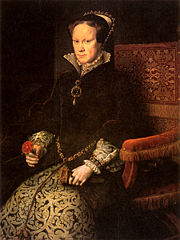
Edward VI died of tuberculosis on 6 July 1553, aged fifteen. His will swept aside the 1543 Act of Succession, excluded both Mary and Elizabeth from the succession, and instead declared as his heir Lady Jane Grey, granddaughter of Henry VIII's sister Mary, Duchess of Suffolk. Lady Jane was proclaimed queen, but her support quickly crumbled, and she was deposed less than two weeks later. Mary rode triumphantly into London, with Elizabeth at her side.
The show of solidarity between the sisters did not last long. Mary was determined to crush the Protestant faith in which Elizabeth had been educated, and she ordered that everyone attend Mass. This included Elizabeth, who had no choice but outwardly to conform. Mary's initial popularity ebbed away when it became known that she planned to marry Prince Philip of Spain, the son of Emperor Charles V. Discontent spread rapidly through the country, and many looked to Elizabeth as a focus for their opposition to Mary's religious policies. In January and February 1554, uprisings broke out (known as Wyatt's rebellion) in several parts of England and Wales, led by Thomas Wyatt.
Once the rising had collapsed, Elizabeth was brought to court and interrogated. On 18 March, she was imprisoned in the Tower of London, where Lady Jane Grey had been executed on 12 February to deter the rebels. The terrified Elizabeth fervently protested her innocence. Though it is unlikely that she had plotted with the rebels, some of them were known to have approached her. Mary's closest confidant, Charles V's ambassador Simon Renard, argued that her throne would never be safe while Elizabeth lived; and the Chancellor, Stephen Gardiner, worked to have Elizabeth put on trial. However, Elizabeth's supporters in the government, among them Lord Paget, convinced Mary to spare her sister in the absence of hard evidence against her. On 22 May, therefore, Elizabeth was moved from the Tower to Woodstock, where she was to spend almost a year under house arrest in the charge of Sir Henry Bedingfield. Crowds cheered her all along the way.
On 17 April 1555, Elizabeth was recalled to court to be closely attended during the final stages of Mary's apparent pregnancy. If Mary and her child died, Elizabeth would become queen. If, on the other hand, Mary gave birth to a healthy child, Elizabeth's chances of becoming queen would recede sharply. When it became clear that Mary was not pregnant, no one believed any longer that she could have a child. Elizabeth's succession seemed assured. Even Philip, who became King of Spain in 1556, acknowledged the new political reality. From this time forward, he cultivated Elizabeth, preferring her to the likely alternative, Mary, Queen of Scots, who was betrothed to the Dauphin of France. When his wife fell ill in 1558, Philip sent the Count of Feria to consult with Elizabeth. By October, Elizabeth was making plans for her government. On 6 November, Mary recognised Elizabeth as her heir.
Queen Elizabeth
Elizabeth became queen at the age of 25. As her triumphal progress wound through the city on the eve of the coronation ceremony, she was welcomed wholeheartedly by the citizens and greeted by orations and pageants, most with a strong Protestant flavour. Elizabeth's open and gracious responses endeared her to the spectators, who were "wonderfully ravished". The following day, 15 January 1559, Elizabeth was crowned at Westminster Abbey and anointed by the Catholic bishop of Carlisle. She was then presented for the people's acceptance, amidst a deafening noise of organs, fifes, trumpets, drums, and bells.
On 20 November 1558, Elizabeth declared her intentions to her Council and other peers who had come to Hatfield to swear allegiance. The speech contains the first record of her often-used metaphor of the "two bodies": the body natural and the body politic:
My lords, the law of nature moves me to sorrow for my sister; the burden that is fallen upon me makes me amazed, and yet, considering I am God's creature, ordained to obey His appointment, I will thereto yield, desiring from the bottom of my heart that I may have assistance of His grace to be the minister of His heavenly will in this office now committed to me. And as I am but one body naturally considered, though by His permission a body politic to govern, so shall I desire you all...to be assistant to me, that I with my ruling and you with your service may make a good account to Almighty God and leave some comfort to our posterity on earth. I mean to direct all my actions by good advice and counsel.
Religion
Elizabeth's conscience was in no doubt that a break with Rome was justified. This coincided with her most powerful lords wish for her to repudiate the Pope and Spanish influence. The policies of Sir William Cecil, her Secretary of State, and her chief advisors were aligned. She also knew that the papacy might never recognise her as the legitimate child of Henry VIII and the rightful ruler of England. She therefore determined to establish an English church suited to the needs of the English people. As a result, the parliament of 1559 started to legislate for a church based on the protestant settlement of Edward VI, with the monarch as its head. The House of Commons backed the proposals strongly, but the bill of supremacy met opposition in the House of Lords, particularly from the bishops. Elizabeth was fortunate, however, that many bishoprics were vacant at the time, including the Archbishopric of Canterbury. This enabled supporters amongst peers to outvote the bishops and conservative peers.
After various negotiations and changes to the wording, which made the act more Catholic in nature, the new Act of Supremacy became law on 8 May 1559. Elizabeth's title was agreed to be Supreme Governor of the Church of England rather than the more contentious Supreme Head. All public officials were to swear an oath of loyalty to the monarch as the supreme governor or risk disqualification from office; however, the heresy laws were repealed, to avoid a repeat of the persecution of dissenters practised by Mary. At the same time, a new Act of Uniformity was passed, which made attendance at church and the use of an adapted version of the 1552 Book of Common Prayer compulsory, though the penalties for disobedience were not extreme.
Marriage question
From the start of Elizabeth's reign, the question arose whom she would marry. However, she never married, and the reasons for this are not clear. Historians have speculated that Thomas Seymour had put her off sexual relationships, or that she knew herself to be infertile. Until bearing a child became impossible, she considered several suitors, the last courtship ending in 1581 when Elizabeth was aged 48, was with François, Duke of Anjou (22 years her junior). However, Elizabeth had no need of a man's help to govern, and marrying risked a loss of control or of foreign interference in her affairs, as had happened to her sister Mary. On the other hand, marriage offered the chance of an heir.
Elizabeth often received offers of marriage, but she only seriously considered three or four suitors for any length of time. Of these, her childhood friend Robert Dudley probably came closest. During 1559, Elizabeth's friendship with the married Dudley seems to have turned to love. Rumour spread through the court that she was sleeping with him; William Cecil, Elizabeth's most trusted advisor, made clear his disapproval. When Dudley's wife, Amy Robsart, was found dead in 1560, under ambiguous circumstances, a great scandal arose. For a time, Elizabeth seriously considered marrying Dudley; but after several months, she put duty ahead of her feelings and decided against the marriage. Dudley, whom she made Earl of Leicester and appointed to the Privy Council, retained a special place in her heart, though her infatuation mellowed in time to a special and lasting friendship. After Elizabeth died, a note from Dudley, who had died in 1588, was found among her possessions, marked "his last letter".
After the Dudley affair, Elizabeth kept the marriage question open but often only as a diplomatic ploy. She appears to have considered marriage out of duty rather than personal preference. Parliament repeatedly petitioned her to marry, but she always answered evasively. In 1563, she told an imperial envoy: "If I follow the inclination of my nature, it is this: beggar-woman and single, far rather than queen and married". In the same year, following Elizabeth's illness with smallpox, the succession question became a heated issue. Parliament urged the queen to marry or nominate an heir, to prevent a civil war upon her death. She refused to do either. In April, she prorogued the Parliament, which did not reconvene until she needed its support to raise taxes in 1566. The House of Commons threatened to withhold funds until she agreed to provide for the succession. In 1566, Sir Robert Bell boldly pursued the issue despite Elizabeth's command to desist and became the target of her anger, saying, "Mr. Bell with his complices must needs prefer their speeches to the upper house to have you my lords, consent with them, whereby you were seduced, and of simplicity did assent unto it."
In 1566, she confided to the Spanish ambassador that if she could find a way to settle the succession without marrying, she would do so. By 1570, senior figures in the government privately accepted that Elizabeth would never marry or name a successor. William Cecil was already seeking solutions to the succession problem. For this stance, as for her failure to marry, she was often accused of irresponsibility. However, Elizabeth's silence strengthened her own political security: she knew that if she named an heir, her throne would be vulnerable to a coup.
Elizabeth's unmarried status inspired a cult of virginity. In poetry and portraiture, she was depicted as a virgin or a goddess or both, not as a normal woman. At first, only Elizabeth made a virtue of her virginity: in 1559, she told the Commons, "And, in the end, this shall be for me sufficient, that a marble stone shall declare that a queen, having reigned such a time, lived and died a virgin". Later on, particularly after 1578, poets and writers took up the theme and turned it into an iconography that exalted Elizabeth. In an age of metaphors and conceits, she was portrayed as married to her kingdom and subjects, under divine protection. In 1599, Elizabeth spoke of "all my husbands, my good people".
Foreign policy
Apart from the Dudley affair, Elizabeth treated the marriage issue as an aspect of foreign policy. Though she turned down Philip II's own offer in 1559, she negotiated for several years to marry his cousin Archduke Charles of Austria. However, relations with the Habsburgs deteriorated by 1568. Elizabeth then considered marriage to two French Valois princes in turn, first Henri, Duke of Anjou, and later, from 1572 to 1581, his brother François, Duke of Anjou. This last proposal was tied to a planned alliance against Spanish control of the Southern Netherlands. Elizabeth seems to have taken the courtship seriously for a time, and wore a frog-shaped earring that Anjou had sent her.
Elizabeth's foreign policy was largely defensive. The exception was the disastrous occupation of Le Havre from October 1562 to June 1563, when Elizabeth's Huguenot allies joined with the Catholics to retake the port. Elizabeth had intended to exchange Le Havre for Calais, retaken by France in January 1558. She sent troops into Scotland in 1560 to prevent the French using it as a base. In 1585, she signed the Treaty of Nonsuch with the Dutch to block the Spanish threat to England. Only through the activities of her fleets did Elizabeth pursue an aggressive policy. This paid off in the war against Spain, 80% of which was fought at sea. She knighted Francis Drake after his circumnavigation of the globe from 1577 to 1580, and he won fame for his raids on Spanish ports and fleets. Her reign also saw the first colonisation or "planting" of new land in North America; and the colony of Virginia was named for her. In truth, however, an element of piracy and self-enrichment drove Elizabethan seafarers, over which the queen had little control.
Scotland
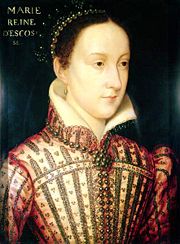
Elizabeth's first policy toward Scotland was to oppose the French presence there. She feared that the French planned to invade England and put Mary, Queen of Scots, who was in effect the heir to the English crown, on the throne. Elizabeth was persuaded to send a force into Scotland to aid the Protestant rebels, and though the campaign was inept, the resulting Treaty of Edinburgh of July 1560 removed the French threat in the north. When Mary returned to Scotland in 1561 to take up the reins of power, the country had an established Protestant church and was run by a council of Protestant nobles supported by Elizabeth. Mary refused to ratify the treaty.
Elizabeth offended Mary by proposing her own former suitor, Robert Dudley, as a husband. Instead, in 1565 Mary married Henry Stuart, Lord Darnley, who carried his own claim to the English throne. The marriage, however, was the first of a series of errors of judgement by Mary that handed the victory to the Scottish Protestants and to Elizabeth. Darnley quickly became unpopular in Scotland and then infamous for presiding over the murder of Mary's Italian secretary David Rizzio. In February 1567, Darnley was murdered by conspirators almost certainly led by James Hepburn, Earl of Bothwell. Shortly afterwards, on 15 May 1567, Mary married Bothwell, arousing suspicions that she had been party to the murder of her husband. Elizabeth wrote to her:
"How could a worse choice be made for your honour than in such haste to marry such a subject, who besides other and notorious lacks, public fame has charged with the murder of your late husband, besides the touching of yourself also in some part, though we trust in that behalf falsely.
These events led rapidly to Mary's defeat and imprisonment in Loch Leven Castle. The Scottish lords forced her to abdicate in favour of her son James, who had been born in June 1566. James was taken to Stirling Castle to be raised as a Protestant. Mary escaped from Loch Leven in 1568 but after another defeat fled across the border into England, where she had once been assured of support from Elizabeth. Elizabeth's first instinct was to restore her fellow monarch; but she and her council instead chose to play safe. Rather than risk returning Mary to Scotland with an English army or sending her to France and the Catholic enemies of England, they detained her in England. She was imprisoned there for the next nineteen years.
Mary was soon the focus for rebellion. In 1569, plotters in the Rising of the North talked of freeing her, and a scheme arose to marry her to Thomas Howard, Duke of Norfolk. Elizabeth reacted by sending Howard to the block. Mary may not have been told of every Catholic plot to put her on the English throne, but from the Ridolfi Plot of 1571 to the Babington Plot of 1586, Elizabeth's spymaster Sir Francis Walsingham and the royal council keenly assembled a case against her. At first, Elizabeth resisted calls for Mary's death. By late 1586, however, she had been persuaded to sanction her trial and execution on the evidence of letters written during the Babington Plot. Elizabeth's proclamation of the sentence announced that "the said Mary, pretending title to the same Crown, had compassed and imagined within the same realm divers things tending to the hurt, death and destruction of our royal person." On 8 February 1587, Mary was beheaded at Fotheringhay Castle, Northamptonshire.
Spain
After the disastrous occupation and loss of Le Havre in 1562–1563, Elizabeth avoided military expeditions on the continent until 1585, when she sent an English army to aid the Protestant Dutch rebels against Philip II. This followed the deaths in 1584 of the allies William the Silent, Prince of Orange, and François, Duke of Anjou, and the surrender of a series of Dutch towns to Alexander Farnese, Duke of Parma, Philip's governor of the Spanish Netherlands. In December 1584, an alliance between Philip II and the French Catholic League at Joinville undermined the ability of Anjou's brother, Henry III of France, to counter Spanish domination of the Netherlands. It also extended Spanish influence along the channel coast of France, where the Catholic League was strong, and exposed England to invasion. The English and the Dutch reacted in August 1585 with the Treaty of Nonsuch, whereby Elizabeth, pressured by her advisors, promised military support to the Dutch. The treaty marked the beginning of the Anglo-Spanish War, which lasted until the Treaty of London in 1604.
Elizabeth did not trust this course of action from the start. The expedition, led by her former suitor, Robert Dudley, Earl of Leicester, achieved nothing. Elizabeth's strategy, to use the English army as a defensive bargaining tool, was soon at odds with that of Dudley, who wanted to fight an active campaign but lacked the resources to do so. He enraged Elizabeth by accepting the post of Governor-General from the Dutch States-General. Elizabeth saw this as a Dutch ploy to embroil her further in their defense. She wrote to him:
We could never have imagined (had we not seen it fall out in experience) that a man raised up by ourself and extraordinarily favoured by us, above any other subject of this land, would have in so contemptible a sort broken our commandment in a cause that so greatly touches us in honour....And therefore our express pleasure and commandment is that, all delays and excuses laid apart, you do presently upon the duty of your allegiance obey and fulfill whatsoever the bearer hereof shall direct you to do in our name. Whereof fail you not, as you will answer the contrary at your utmost peril.
Elizabeth and her parliament's failure to send Dudley sufficient money and troops, combined with his own incompetence as a military leader, doomed the campaign to impotence. Dudley finally resigned his command in December 1587, his reputation in tatters. By that time, Philip II had decided to take the war to England.
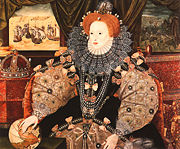
On 12 July 1588, the Spanish Armada, a great fleet of ships, set sail for the channel, planning to ferry a Spanish invasion force under the Duke of Parma to the coast of southeast England from the Netherlands. The armada, however, was defeated by a combination of miscalculation, misfortune, and an attack of English fire ships on 29 July off Gravelines which dispersed the Spanish ships to the northeast. The armada straggled home to Spain in shattered remnants, after disastrous losses on the coast of Ireland (after some ships had tried to struggle back to Spain via the North Sea, and then back south past the west coast of Ireland). Unaware of the armada's fate, English forces mustered to defend the country. Elizabeth inspected her troops at Tilbury in Essex on 8 August. Wearing a silver breastplate over a white velvet dress, she addressed them in one of her most famous speeches:
My loving people, we have been persuaded by some that are careful of our safety, to take heed how we commit ourself to armed multitudes for fear of treachery; but I assure you, I do not desire to live to distrust my faithful and loving people....I know I have the body but of a weak and feeble woman, but I have the heart and stomach of a king, and of a King of England too, and think foul scorn that Parma or Spain, or any Prince of Europe should dare to invade the borders of my realm.
When no invasion came, the nation rejoiced. Elizabeth's procession to a thanksgiving service at St Paul's Cathedral rivalled that of her coronation as a spectacle. The defeat of the armada was a potent propaganda victory, both for Elizabeth and for Protestant England. The English took their delivery as a symbol of God's favour and of the nation's inviolability under a virgin queen. However, the victory was not a turning point in the war, which continued and often favoured Spain. The Spanish still controlled the Netherlands, and the threat of invasion remained. Sir Walter Raleigh claimed after her death that Elizabeth's caution had impeded the war against Spain:
If the late queen would have believed her men of war as she did her scribes, we had in her time beaten that great empire in pieces and made their kings of figs and oranges as in old times. But her Majesty did all by halves, and by petty invasions taught the Spaniard how to defend himself, and to see his own weakness.
Though some historians have criticised Elizabeth on similar grounds, Raleigh's verdict has more often been judged unfair. Elizabeth had good reason not to place too much trust in her commanders, who once in action tended, as she put it herself, "to be transported with an haviour of vainglory".
France
When the Protestant Henry IV inherited the French throne in 1589, Elizabeth sent him military support. It was her first venture into France since the retreat from Le Havre in 1563. Henry's succession was strongly contested by the Catholic League and by Philip II, and Elizabeth feared a Spanish takeover of the channel ports. The subsequent English campaigns in France, however, were disorganised and ineffective. Lord Willoughby, largely ignoring Elizabeth's orders, roamed northern France to little effect, with an army of 4,000 men. He withdrew in disarray in December 1589, having lost half his troops. In 1591, the campaign of John Norreys, who led 3,000 men to Brittany, was even more of a disaster. As for all such expeditions, Elizabeth was unwilling to invest in the supplies and reinforcements requested by the commanders. Norreys left for London to plead in person for more support. In his absence, a Catholic League army almost destroyed the remains of his army at Craon, north-west France, in May 1591. In July, Elizabeth sent out another force under Robert Devereux, Earl of Essex, to help Henry IV in besieging Rouen. The result was just as dismal. Essex accomplished nothing and returned home in January 1592. Henry abandoned the siege in April. As usual, Elizabeth lacked control over her commanders once they were abroad. "Where he is, or what he doth, or what he is to do," she wrote of Essex, "we are ignorant".
Ireland
Although Ireland was one of her two kingdoms, Elizabeth faced a hostile—and in places virtually autonomous—Catholic population that was willing to plot with her enemies. Her policy there was to grant land to her courtiers and prevent the rebels from giving Spain a base from which to attack England. In response to a series of uprisings, the English forces pursued scorched-earth tactics, burning the land and slaughtering man, woman and child. During a revolt in Munster led by Gerald FitzGerald, Earl of Desmond, in 1582, an estimated 30,000 Irish people starved to death. The poet Edmund Spenser wrote that the victims "were brought to such wretchedness as that any stony heart would have rued the same". Elizabeth advised her commanders that the Irish, "that rude and barbarous nation", be well treated; but she showed no remorse when force and bloodshed were deemed necessary.
Between 1594 and 1603, Elizabeth faced her most severe test in Ireland, with the revolt known as Tyrone's Rebellion, or the Nine Years War. Its leader, Hugh O'Neill, Earl of Tyrone, was backed by Spain. In spring 1599, Elizabeth sent Robert Devereux, 2nd Earl of Essex, to put the revolt down. To her frustration, he made little progress and returned to England without permission. He was replaced by Charles Blount, Lord Mountjoy, who took three years to defeat the rebels. O'Neill finally surrendered in 1603, a few days after Elizabeth's death.
Later years and death
As Elizabeth aged and marriage became unlikely, her image gradually changed. She was portrayed as Belphoebe or Astraea, and after the Armada, as Gloriana, the eternally youthful Faerie Queene of Edmund Spenser's poem. Her painted portraits became less realistic and more a set of enigmatic icons that made her look much younger than she was. In fact, her skin had been scarred by smallpox in 1562, leaving her half bald and dependent on wigs and cosmetics. Sir Walter Raleigh called her "a lady whom time had surprised". However, the more Elizabeth's beauty faded, the more her courtiers praised it.
Elizabeth was happy to play the part, but it is possible that in the last decade of her life she began to believe her own performance. She became fond and indulgent of the charming but petulant young Robert Devereux, Earl of Essex, who took liberties with her for which she forgave him. She repeatedly appointed him to military posts despite his growing record of irresponsibility. After Essex's desertion of his command in Ireland in 1599 (returning to England from Ireland against Elizabeth's express command), Elizabeth had him placed under house arrest and the following year deprived him of his monopolies. In February 1601, the earl tried to raise a rebellion in London. He intended to seize the queen but few rallied to his support, and he was beheaded on 25 February. Elizabeth knew that her own misjudgements were partly to blame for this turn of events. An observer reported in 1602 that "Her delight is to sit in the dark, and sometimes with shedding tears to bewail Essex".
The monopolies Elizabeth reclaimed from Essex were her typical reward to a courtier during the last years of her reign. She had come to rely on this cost-free system of patronage rather than ask Parliament for more subsidies in a time of war. The practice soon led to price-fixing, the enrichment of courtiers at the public's expense, and widespread resentment. This culminated in agitation in the House of Commons during the parliament of 1601. In her famous " Golden Speech" of 30 November 1601, Elizabeth professed ignorance of the abuses and won the members over with promises and her usual appeal to the emotions:
Who keeps their sovereign from the lapse of error, in which, by ignorance and not by intent they might have fallen, what thank they deserve, we know, though you may guess. And as nothing is more dear to us than the loving conservation of our subjects' hearts, what an undeserved doubt might we have incurred if the abusers of our liberality, the thrallers of our people, the wringers of the poor, had not been told us!
The period after the defeat of the Spanish Armada in 1588 brought new difficulties for Elizabeth that lasted the fifteen years until the end of her reign. The conflicts with Spain and in Ireland dragged on, the tax burden grew heavier, and the economy was hit by poor harvests and the cost of war. Prices rose and the standard of living fell. During this time, repression of Catholics intensified, and Elizabeth authorised commissions in 1591 to interrogate and monitor Catholic householders. To maintain the illusion of peace and prosperity, she increasingly relied on internal spies and propaganda. In her last years, mounting criticism reflected a decline in the public's affection for her.
This same period of economic and political uncertainty, however, produced an unsurpassed literary flowering in England. The first signs of a new literary movement had appeared at the end of the second decade of Elizabeth's reign, with John Lyly's Euphues and Edmund Spenser's The Shepheardes Calender in 1578. During the 1590s, some of the great names of English literature entered their maturity, including William Shakespeare and Christopher Marlowe. During this period and into the Jacobean era that followed, the English theatre reached its highest peaks. The notion of a great Elizabethan age depends largely on the builders, dramatists, poets, and musicians who were active during Elizabeth's reign. They owed little directly to the queen, who was never a major patron of the arts.

Elizabeth's most trusted advisor, Burghley, died on 4 August 1598. His political mantle passed to his son, Robert Cecil, who soon became the leader of the government. One task he addressed was to prepare the way for a smooth succession. Since Elizabeth would never name her successor, Cecil was obliged to proceed in secret. He therefore entered into a coded negotiation with James VI of Scotland, who had a strong but unrecognised claim. Cecil coached the impatient James to humour Elizabeth and "secure the heart of the highest, to whose sex and quality nothing is so improper as either needless expostulations or over much curiosity in her own actions". The advice worked. James's tone delighted Elizabeth, who responded: "So trust I that you will not doubt but that your last letters are so acceptably taken as my thanks cannot be lacking for the same, but yield them to you in grateful sort". In historian J. E. Neale's view, Elizabeth may not have declared her wishes openly to James, but she made them known with "unmistakable if veiled phrases".
The Queen's health remained fair until the autumn of 1602, when a series of deaths among her friends plunged her into a severe depression. In February 1603, the death of her cousin and close friend, Catherine Carey, Countess of Nottingham, came as a particular blow. In March, Elizabeth fell sick and remained in a "settled and unremovable melancholy". She died on 24 March 1603 at Richmond Palace, between two and three in the morning. A few hours later, Cecil and the council set their plans in motion and proclaimed James VI of Scotland as James I of England.
Elizabeth's coffin was carried downriver at night to Whitehall, on a barge lit with torches. At her funeral on 28 April, the coffin was taken to Westminster Abbey on a hearse drawn by four horses hung with black velvet. In the words of the chronicler John Stow:
Westminster was surcharged with multitudes of all sorts of people in their streets, houses, windows, leads and gutters, that came out to see the obsequy, and when they beheld her statue lying upon the coffin, there was such a general sighing, groaning and weeping as the like hath not been seen or known in the memory of man.
Legacy
Elizabeth was lamented, but the people were relieved at her death. A new age was born, and at first the signs were good, with the ending of the war against Spain in 1604 and lower taxes. Until the death of Robert Cecil in 1612, the government ran along much the same lines as before. James I's rule, however, became unpopular when he turned state affairs over to court favourites, and in the 1620s there was a nostalgic revival of the cult of Elizabeth. Elizabeth was praised as a heroine of the Protestant cause and the ruler of a golden age. James was depicted as a Catholic sympathiser, presiding over a corrupt court. The triumphalist image that Elizabeth had cultivated towards the end of her reign, against a background of factionalism and military and economic difficulties, was taken at face value and her reputation inflated. Godfrey Goodman, Bishop of Gloucester, recalled: "When we had experience of a Scottish government, the Queen did seem to revive. Then was her memory much magnified." Elizabeth's reign became idealised as a time when crown, church and parliament had worked in constitutional balance.
The picture of Elizabeth painted by her Protestant admirers of the early 17th century has proved lasting and influential. Her memory was also revived during the Napoleonic Wars, when the nation again found itself on the brink of invasion. In the Victorian era, the Elizabethan legend was adapted to the imperial ideology of the day, and in the mid-20th century, Elizabeth was a romantic symbol of the national resistance to foreign threat. Historians of that period, such as J. E. Neale (1934) and A. L. Rowse (1950), interpreted Elizabeth's reign as a golden age of progress.
Recent historians, however, have taken a more complicated view of Elizabeth. Her reign is famous for the defeat of the Armada, and for successful raids against the Spanish, such as those on Cádiz in 1587 and 1596, but some historians point to military failures on land and at sea, such as the "Islands voyage" to the Azores, of 1597 (where Robert Devereux, 2nd Earl of Essex defied the Queen's orders, and pursued the Spanish treasure fleet before ensuring that the Spanish navy was out of action). Elizabeth's problems in Ireland also stain her record. Rather than as a brave defender of the Protestant nations against Spain and the Habsburgs, she is more often regarded as cautious in her foreign policies. She offered minimal aid to foreign Protestants and failed to provide her commanders with the funds to make a difference abroad.
Elizabeth established an English church that helped shape a national identity and remains in place today. Those who praised her later as a Protestant heroine overlooked her refusal to drop all Catholic practices. Historians note that in her day, strict Protestants regarded the Acts of Settlement and Uniformity of 1559 as a compromise. In fact, Elizabeth believed that faith was personal and did not wish, as Francis Bacon put it, to "make windows into men's hearts and secret thoughts".
Despite Elizabeth's largely defensive foreign policy, her reign raised England's status abroad. "She is only a woman, only mistress of half an island," marvelled Pope Sixtus V, "and yet she makes herself feared by Spain, by France, by the Empire, by all". Under Elizabeth, the nation gained a new self-confidence and sense of sovereignty, as Christendom fragmented. Elizabeth was the first Tudor to recognise that a monarch ruled by popular consent. She therefore always worked with parliament and advisers she could trust to tell her the truth—a style of government that her Stuart successors failed to follow. Some historians have called her lucky; she believed that God was protecting her. Priding herself on being "mere English", Elizabeth trusted in God, honest advice, and the love of her subjects for the success of her rule. In a prayer, she offered thanks to God that:
[At a time] when wars and seditions with grievous persecutions have vexed almost all kings and countries round about me, my reign hath been peacable, and my realm a receptacle to thy afflicted Church. The love of my people hath appeared firm, and the devices of my enemies frustrate.
Ancestors
|
|
||||||||||||||||||||||||||||||||||||||||||||||||||||||||||||||||||||||||||||||||||||||||||||||||||||||||||||||||||||||||||||||||||||||||||||||||||||||||||||||||||||||||||||||||||||||||||||||||||||||||||||||||||||||||||||||||||||||||||||||||||||||||||||||||||||||||||||||||||||||||||||||||||||||||||||||||||||||||||||||||||||||||||||||||||||||||||||||||||||||||||||||||||||||||||||||||||||||||||||||||||||||||||||||||||||||||||||||||||||||||||||||||||||||||||||||||||||||||||||||||||||||||||||||||||||||||||||||||||||||||||||||||||||||||||||||||||
|---|---|---|---|---|---|---|---|---|---|---|---|---|---|---|---|---|---|---|---|---|---|---|---|---|---|---|---|---|---|---|---|---|---|---|---|---|---|---|---|---|---|---|---|---|---|---|---|---|---|---|---|---|---|---|---|---|---|---|---|---|---|---|---|---|---|---|---|---|---|---|---|---|---|---|---|---|---|---|---|---|---|---|---|---|---|---|---|---|---|---|---|---|---|---|---|---|---|---|---|---|---|---|---|---|---|---|---|---|---|---|---|---|---|---|---|---|---|---|---|---|---|---|---|---|---|---|---|---|---|---|---|---|---|---|---|---|---|---|---|---|---|---|---|---|---|---|---|---|---|---|---|---|---|---|---|---|---|---|---|---|---|---|---|---|---|---|---|---|---|---|---|---|---|---|---|---|---|---|---|---|---|---|---|---|---|---|---|---|---|---|---|---|---|---|---|---|---|---|---|---|---|---|---|---|---|---|---|---|---|---|---|---|---|---|---|---|---|---|---|---|---|---|---|---|---|---|---|---|---|---|---|---|---|---|---|---|---|---|---|---|---|---|---|---|---|---|---|---|---|---|---|---|---|---|---|---|---|---|---|---|---|---|---|---|---|---|---|---|---|---|---|---|---|---|---|---|---|---|---|---|---|---|---|---|---|---|---|---|---|---|---|---|---|---|---|---|---|---|---|---|---|---|---|---|---|---|---|---|---|---|---|---|---|---|---|---|---|---|---|---|---|---|---|---|---|---|---|---|---|---|---|---|---|---|---|---|---|---|---|---|---|---|---|---|---|---|---|---|---|---|---|---|---|---|---|---|---|---|---|---|---|---|---|---|---|---|---|---|---|---|---|---|---|---|---|---|---|---|---|---|---|---|---|---|---|---|---|---|---|---|---|---|---|---|---|---|---|---|---|---|---|---|---|---|---|---|---|---|---|---|---|---|---|---|---|---|---|---|---|---|---|---|---|---|---|---|---|---|---|---|---|---|---|---|---|---|---|---|---|---|---|---|---|---|---|---|---|---|---|---|---|---|---|---|---|---|---|---|---|---|---|---|---|---|---|---|---|---|---|---|---|---|---|---|---|---|---|---|---|---|---|---|---|---|---|---|---|---|---|---|---|---|---|---|---|---|---|---|---|---|---|---|---|---|---|---|---|---|---|---|---|---|---|---|---|---|---|---|---|---|---|---|---|---|---|---|---|---|---|---|---|---|---|---|---|---|---|---|---|---|---|---|---|---|---|---|
|
||||||||||||||||||||||||||||||||||||||||||||||||||||||||||||||||||||||||||||||||||||||||||||||||||||||||||||||||||||||||||||||||||||||||||||||||||||||||||||||||||||||||||||||||||||||||||||||||||||||||||||||||||||||||||||||||||||||||||||||||||||||||||||||||||||||||||||||||||||||||||||||||||||||||||||||||||||||||||||||||||||||||||||||||||||||||||||||||||||||||||||||||||||||||||||||||||||||||||||||||||||||||||||||||||||||||||||||||||||||||||||||||||||||||||||||||||||||||||||||||||||||||||||||||||||||||||||||||||||||||||||||||||||||||||||||||||
